Day 2 of a three day long weekend of Winter & Owl Tours, and we headed down to the Norfolk Broads today. It was frosty overnight and cloudy today, although it did brighten up a bit later on and there was no sign of any of the forecast patchy fog.
Our first stop was at Ludham. The field which had held all the swans last time we were down was looking comparatively empty today. There were six Bewick’s Swans here – we got them in the scope and could see the squared off yellow on the adults’ bills – but no sign of the rest of the big herd. The large flock of Egyptian Geese were still here though – about 30 today.
 Egyptian Goose – part of the large flock still at Ludham
Egyptian Goose – part of the large flock still at Ludham
This is a good vantage point from which to scan the rest of the old airfield and we could see some more white shapes distantly away to the north. So we set off round to the other side for a closer look. Sure enough, we found the rest of the swans, though they were separated into two groups. We stopped by the first group which were feeding in a winter wheat field. There were 73 swans in total in this field – 13 Whooper Swans and 60 Bewick’s Swans. Another two pairs of Bewick’s Swans flew in calling and dropped down to join them.
 Whooper & Bewick’s Swans – part of the herd between Ludham & Catfield
Whooper & Bewick’s Swans – part of the herd between Ludham & Catfield
It is always nice to see the two species side by side. Next to the Bewick’s Swans, the Whooper Swans are much larger and longer necked. Their bills are also proportionately longer, and the yellow on the bill extends down towards the tip in a pointed wedge. In contrast, the Bewick’s Swans’ yellow is more restricted and squared off. There was also a lone Pink-footed Goose in the field with them.
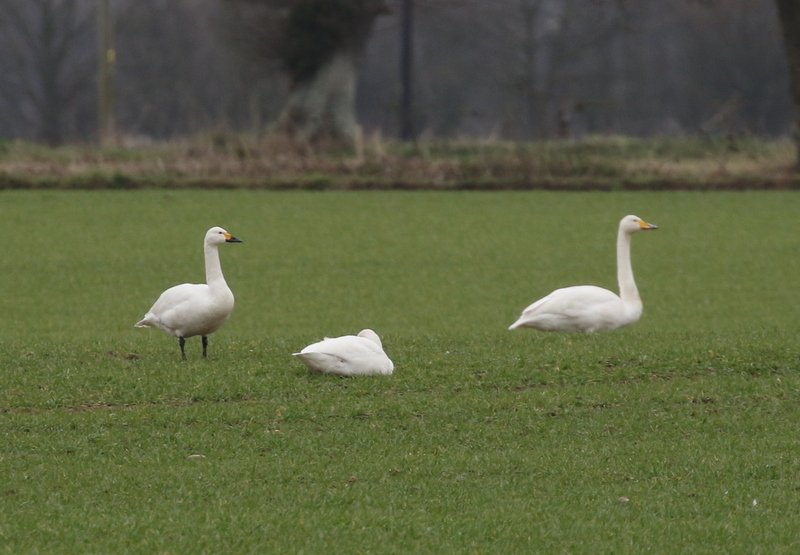 Bewick’s & Whooper Swans – nicely showing the size & bill differences
Bewick’s & Whooper Swans – nicely showing the size & bill differences
Having had a good look at this group of swans, we drove a little further up the road and found a much larger herd. There was no easy place to stop here, but we managed a quick count – there were at least 108 birds in total, again a mixture of Whooper Swans and Bewick’s Swans, and predominantly the latter.
Our next target was to find some Cranes. We drove further into the Broads and stopped at a convenient vantage point from where we can see across an area where we know they like to feed. A quick scan of the marshes and we could see a single Crane some distance away, so we got out of the car and set up the scopes. Now there was no sign of it! For a bird which stands over a metre tall, they can be very hard to see and it had walked some distance along behind some reeds. As it walked back out, we could see there were two Cranes and then they took to the air and we could see there were actually four of them.
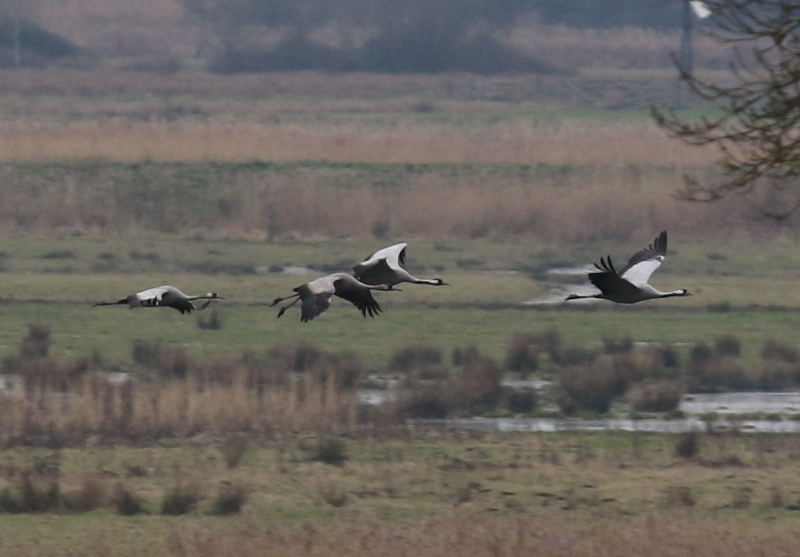 Cranes – a family party, two adults and two juveniles
Cranes – a family party, two adults and two juveniles
The Cranes flew off behind some trees but a minute or so later they reappeared again. At the same time, another pair of Cranes appeared and flew over past them and disappeared from view. When the part of four landed back down on the marshes, we looked across to see yet another pair still down in the field beyond, making eight birds in total. Not a bad start to our Crane viewing!
We got the scopes on the party of four Cranes and could see there were two brighter adults and two duller grey juveniles, with less well-marked head patterns. We watched them walking around on the grass feeding.
 Cranes – the family of four were feeding out on the marshes
Cranes – the family of four were feeding out on the marshes
After a helpful tip off from some locals that the Taiga Bean Geese were showing at Buckenham, we made our way straight over there next. After walking over the railway line, we stopped on the track and scanned the grazing marshes. Sure enough, we could see the six Taiga Bean Geese out in the grass towards their favoured corner. We had a look at them from here, through the scope, then quickly scanned the rest of the marshes.
There were a couple of Chinese Water Deer feeding out on the grass in front, so we stopped to have a good look at those. While we did so, we heard a Redpoll calling and watched it drop into a large bush overhanging one of the ditches. It had presumably come in to bathe or drink, because it quickly dropped down out of view. We walked round to the other side of the bush but couldn’t see it, then as we made our way back, three Redpolls flew off calling. Next, a single Siskin dropped in to the same bush but, more helpfully, it perched in the top for a few seconds so we could get a look at it. There were also two Redwings which flew in and landed in the tops of the trees the other side of the railway line.
We decided to walk down along the platform to try to get a closer look at the Taiga Bean Geese. Unfortunately, by this stage they had walked back further across the marshes, so were still not especially close. Still, when they put their heads up we could see the more extensive orange on their bills, compared to the Tundra Beans we had seen yesterday.
 Taiga Bean Goose – 1 of the 6 still at Buckenham, helpfully with its head up
Taiga Bean Goose – 1 of the 6 still at Buckenham, helpfully with its head up
Back to the track, and we walked on down towards the river. There were not many Wigeon beside the track today – they were all much further out, across the back of the marshes. A smart adult Peregrine was perched out on a tussock, so had possibly flushed all the wildfowl from this side. The Common Snipe were also very nervous – at least thirty of them flew up from the marshes and circled round before dropping back down onto the edge of one of the channels in a tight flock.
There were lots more geese further over, towards the river, the majority being Pink-footed Geese. As we walked along, we periodically stopped to scan through them. In the first group nearest to us we found two White-fronted Geese. When they put their heads up we could see the white surround to their bills and their black belly bars. There were lots more White-fronted Geese scattered through the flocks of Pinkfeet further back too.
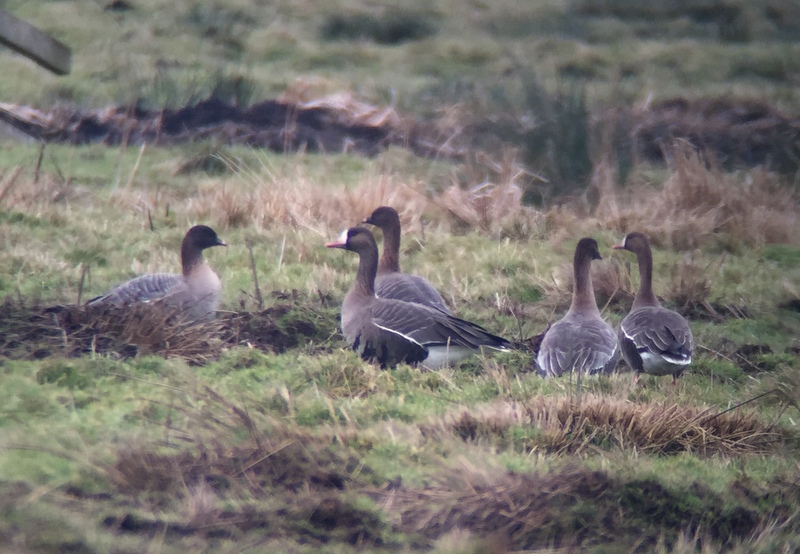 White-fronted Geese – two were with the nearest group of Pinkfeet
White-fronted Geese – two were with the nearest group of Pinkfeet
Out by the river, the pools were partly frozen and devoid of ducks. We had a quick look at the river itself from up on the bank, but all we could see were a few ducks, Mallard, Teal and Wigeon. In the field by the hide, a pair of Stonechats were feeding, perching on the taller dead seedheads. It was cold out on the marshes, exposed to the chill of the light wind, so we decided to head back. The Stonechats lead the way, and we met them again half way back.
 Stonechat – a pair were feeding on the marshes at Buckenham
Stonechat – a pair were feeding on the marshes at Buckenham
Strumpshaw Fen provided a sheltered picnic table for lunch, and the option of a hot drink from the visitor centre. The pool by Reception Hide was still largely frozen and most of the ducks were feeding in the small patch of open water by the reeds, or standing around on the ice. There were quite a few Gadwall, plus a handful of Teal and Shoveler, and the ubiquitous Mallards. The Black Swan had found somewhere quieter, a little further back.
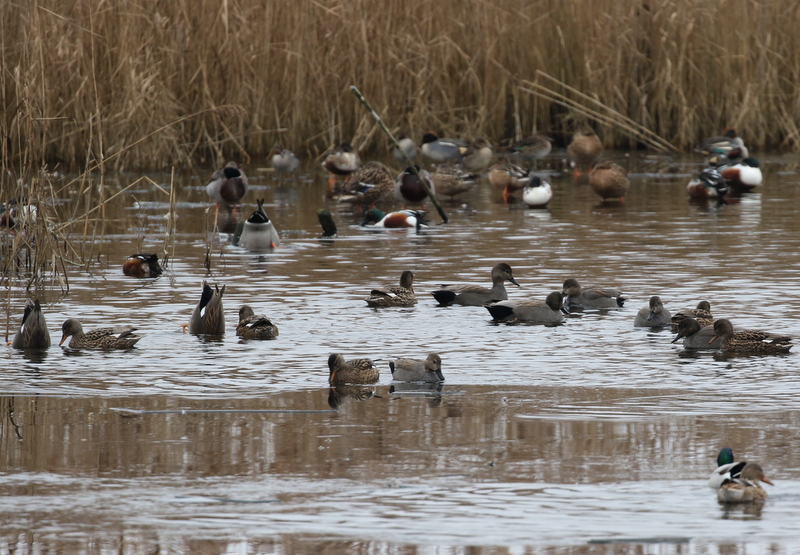 Gadwall, Teal, Shoveler & Mallard – around the small area of open water
Gadwall, Teal, Shoveler & Mallard – around the small area of open water
While we were eating lunch, we kept one eye on the feeders nearby. There was a steady stream of Blue Tits and Great Tits coming and going. Periodically a Marsh Tit would dart in, grab a sunflower heart, and dart back out to the bushes behind. A single Coal Tit popped in briefly too. Nearby, in the trees, a Lesser Redpoll appeared in the tops briefly. Some mournful piping calls alerted us to a smart male Bullfinch, which flew in and landed in a tree briefly, before flying off over towards the railway.
After lunch, we drove round via Halvergate. The four Cattle Egrets which were here at the start of January have now been reduced to one and even that only seems to visit here very occasionally. We had a quick look but couldn’t see it. Just a single Little Egret flew up from the grass and dropped down behind some reeds further over.
Haddiscoe Island is a great place for raptors and owls, so we wanted to have a look there next. There has been a Rough-legged Buzzard here this winter, but at first all we could find were a few Common Buzzards, including a stunningly pale one with very white underparts.
We could hear Bearded Tits calling so we stopped by the reeds and managed to find four feeding in the tops. Two males with powder blue heads and black moustaches and two browner females, we had a great view of them.
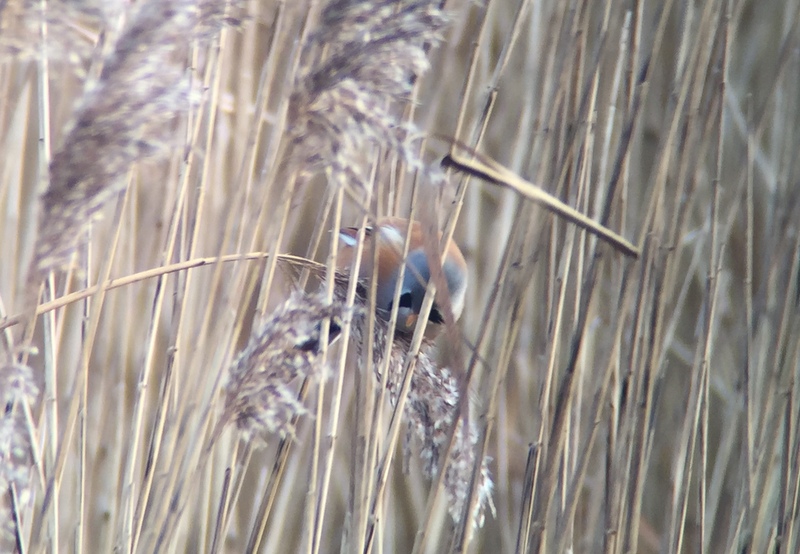 Bearded Tit – one of the males feeding in the reeds
Bearded Tit – one of the males feeding in the reeds
There were lots of other raptors too. A Merlin had a dogfight with a pipit, climbing high into the air, the two birds jinking and swooping in unison, before the Merlin eventually lost interest. A little later, we found another, a smart male Merlin perched on a gatepost, with a Sparrowhawk on another gate nearby. A ghostly grey male Hen Harrier worked its way backwards and forwards over the grass. A Barn Owl flew up and down along the river banks.Time was running out, and we were about to leave when we finally found the Rough-legged Buzzard perched on a post out on Haddiscoe Island.
Our final destination for the day was Stubb Mill. Given the time we spent at Haddiscoe, we were later than we had hoped for getting back round there. On the way, we passed the area where we had seen the Cranes earlier just as the family of four took off to fly to roost. We could see them from the car as they flew over the trees parallel with us. We left them behind, but were stopped by some roadworks further along. Once we eventually got through the lights, we found the four Cranes had overtaken us and nearly flew over the car. On the walk out to the watchpoint, we were treated to the evocative sound of Cranes bugling beyond the trees. We were a bit late this evening, but thankfully, when we got there, it didn’t sound like we had missed anything yet.
There were already a few Marsh Harriers in to roost, perched out in the bushes in the reeds. A steady stream of more Marsh Harriers flew in to join them, coming in from all different directions. It didn’t take long for the first Hen Harrier to appear, another grey male, flying in through the bushes at the back, over the reeds. A short while later, a ringtail Hen Harrier flew in too, a little closer, along the front edge of the reeds. It was hotting up!
There were other birds here too. A flock of Fieldfares were hiding down in the grass behind the reeds until they flew up and all landed in a low hawthorn bush, where we could get them in the scope. A Tawny Owl hooted from the trees behind us. A Barn Owl flew in across the marshes and round behind the mill.
The two resident Cranes were hiding behind the reeds – we could just see the occasional head pop up for a second. Then we spotted another pair coming in to roost, flying in distantly to the east, over beyond Horsey Mill, before dropping down behind the bushes. It seemed like that might be it, until just when most people had started to leave, we heard Cranes calling away to the north. We scanned over in that direction and picked up a large flock flying in, twenty Cranes, all in the air together. It was quite a spectacle!
The Cranes were in two groups. Eleven of them appeared to drop down into the reeds, and three more peeled off from the other nine, which had been slightly ahead of them. These three turned back and seemed to go down towards where the eleven had gone. The final six Cranes carried on, flying steadily south and right past in front of the watchpoint. A great sight! As they flew over calling, the resident pair bugled back to them and finally emerged from where they had been hiding. That was a perfect way to end the day – 24 Cranes in total this evening, taking our total for the day to a whopping 32.
We walked back with flocks of White-fronted Geese and Pink-footed Geese heading off to roost and with the sound of more Cranes bugling still across the marshes.
















